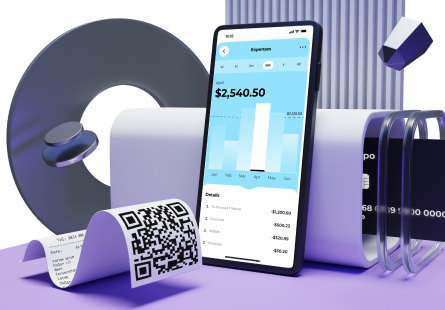The financial landscape has been experiencing a remarkable transformation, with Banking as a Service (BaaS) being one of the innovative approaches that reshape how financial services are delivered.
What is Banking as a Service? How does Banking as a Service work? What are some Banking as a Service examples? Read on to find the answers to these questions and even more.
What is Banking as a Service (BaaS)?
Banking as a Service is a model where traditional banking functions and features are offered as digital services to third-party companies, enabling them to integrate these services into their applications and platforms.
In simpler terms, Banking as a Service is a toolbox with a wide array of banking tools, technology, and infrastructure that companies can utilise to provide financial services without building an entire bank from scratch. This concept allows innovative startups, fintech companies, and non-financial businesses to incorporate banking services into their offerings, enhancing customer experiences and expanding service portfolios.
The idea behind Banking as a Service is to remove the complexities associated with banking operations, such as legal compliance, account management, transaction processing, and security, and provide these functionalities as accessible and customisable APIs (Application Programming Interfaces).
Understanding the evolution of BaaS
The concept of Banking as a Service has its roots in the broader trend of digital transformation that has been reshaping industries across the globe. As technology advanced and consumer expectations evolved, the financial services industry underwent a significant shift toward digitisation and convenience. This shift created the foundation for the advent of Banking as a Service, marking a new era in conceptualising and delivering financial services.
Early digital banking
The journey towards Banking as a Service can be traced back to the early stages of digital banking. As financial institutions began offering online banking platforms in the late 20th century, customers gained the ability to access their accounts and make transactions from the comfort of their homes. This marked the initial steps towards separating banking services from the traditional brick-and-mortar experience.
Rise of fintech and APIs
The dramatic growth of fintech companies in the 21st century played a crucial role in pushing the BaaS model ahead. Fintech startups disrupted the financial industry by introducing innovative solutions that leveraged technology to enhance financial services. The development and standardisation of APIs enabled seamless integration between different software systems.
Unbundling financial services
With APIs as a backbone, the unbundling of financial services became possible. Instead of relying on a single institution to provide all banking functions, businesses could now select specialised services that suited their needs. This was when modular banking was born, where various components — payments, lending, identity verification etc. — could be accessed individually and integrated into different applications.
Birth of Banking as a Service
These trends led to the birth of Banking as a Service. Companies that specialised in providing banking infrastructure and services recognised the potential of offering their capabilities to other businesses. These capabilities extended beyond basic transactions and encompassed complex financial operations, risk management, and regulatory compliance. BaaS became a bridge that connected traditional banking with the agile, tech-driven ecosystem.
Expanding ecosystem
As the BaaS ecosystem expanded, more players, including traditional banks, tech giants, and even non-banking businesses, entered the field. This diversity further enriched the BaaS landscape, offering various services catering to varying business requirements. From startups seeking to launch innovative apps to established companies looking to enhance their financial offerings, Banking as a Service became a solution that addressed a multitude of needs.
How does Banking as a Service (BaaS) work?
Banking as a Service allows businesses that are not traditional financial institutions to provide banking-like services to their customers, which is achieved using APIs and technological infrastructure offered by Banking as a Service providers.
Here’s a breakdown of how the process works:
BaaS providers and APIs
BaaS providers are companies that specialise in offering various banking functionalities as services. These functionalities range from opening financial accounts and processing transactions to handling compliance and risk management. Banking as a Service providers create APIs that allow external applications and platforms to seamlessly interact with their systems.
Integration
Companies interested in leveraging BaaS integrate these pre-built APIs into their applications. For example, a fintech startup developing a budgeting app may integrate a BaaS API to facilitate transactions, track account balances, or offer lending services.
Customisation
Companies can select the exact services they require, tailoring their offerings to match their target audience and business objectives. This modular approach enables greater flexibility and scalability since businesses can add or modify services as they evolve.
Compliance and security
Banking as a Service providers handle the regulatory aspects of finance services, relieving businesses of legal burdens and ensuring that the services offered through their APIs adhere to industry standards and regulations.
Global reach
BaaS allows businesses to extend their services beyond their local markets. They can tap into the BaaS provider’s infrastructure to offer cross-border transactions and international financial services without establishing physical operations in multiple regions.

What are the advantages of embedded finance?
Embedded finance refers to the integration of financial services and products directly into non-financial platforms, applications, or ecosystems. It allows businesses, often from various industries like e-commerce, technology, or retail, to offer financial services seamlessly to their customers without the need for those customers to leave the platform. In essence, embedded finance enables end-users to access financial services, such as payments, loans, insurance, or investments, as a part of their interactions within other digital platforms or services.
Embedded finance is a growing trend that offers a range of benefits to clients, banks, and businesses.
Benefits for a client
Convenience and accessibility
Banking as a Service allows clients to access financial services without switching between different apps or platforms. Whether making payments, managing savings, or obtaining loans, these services are readily available within the apps they already use.
Tailored solutions
Embedded finance allows clients to receive personalised financial solutions based on their behaviour and preferences, creating a more relevant and engaging experience.
Streamlined user experience
With embedded finance, clients can perform financial tasks within the same interface they are familiar with, streamlining their interactions and reducing the learning curve associated with using new applications.
Faster transactions
Integrated financial services often result in quicker transactions, especially in scenarios like one-click payments or instant loan approvals.
Enhanced security
Embedded finance solutions generally offer advanced security measures, utilising encryption and multifactor authentication to ensure the safety of financial transactions and data.
Benefits for a bank
Expanded customer base
Partnering with non-financial businesses allows banks to tap into new customer segments that might have otherwise been inaccessible.
Cost savings
Collaborating with non-banking entities enables banks to reduce operational costs by leveraging their partners’ existing infrastructure and customer base.
Data-driven insights
Embedded finance provides banks with access to valuable customer behaviour and transaction data, which can be used to develop targeted products and improve decision-making.
Partnership opportunities
Banks can forge partnerships with businesses that have an established level of trust, enhancing the bank’s brand image.
Benefits for a business
Enhanced customer loyalty
Offering financial services within a non-financial app creates a more comprehensive user experience, increasing customer loyalty and feeding into more extended engagement.
Additional revenue streams
Businesses can generate new revenue sources by earning fees or commissions from financial transactions facilitated through their platforms.
Competitive edge
Embedded finance sets businesses apart from competitors by providing value-added services that enhance customer satisfaction and retention.
Cross-selling opportunities
Companies can cross-sell financial products and services to their existing customer base, increasing revenue without extensive marketing efforts.
Data utilisation
Embedded finance generates data that businesses can analyse to obtain insights into customer behaviour and preferences, enabling them to refine their service offerings.
BaaS challenges
While Banking as a Service offers numerous advantages, it also presents specific challenges that businesses and providers must navigate to ensure a successful implementation. These challenges include:
Regulatory compliance
BaaS involves handling sensitive financial data and transactions, which requires strict adherence to financial regulations. Ensuring compliance with varying regulations across different regions can be complex and resource-intensive.
Security concerns
Integrating financial services through APIs exposes potential vulnerabilities that cybercriminals could exploit. Given that, maintaining robust cybersecurity measures to protect user data and financial transactions is paramount.
Data privacy
BaaS involves the exchange of personal and financial data. Managing data privacy concerns and complying with data protection regulations, such as GDPR, is a critical challenge.
Integration complexity
Integrating BaaS APIs into existing applications can be technically challenging. Ensuring smooth and seamless integration without disrupting user experience requires careful planning and expertise.
Market competition
As the popularity of BaaS grows, more providers enter the market. This competition can lead to a crowded landscape, making it essential for businesses to choose the right provider for their needs.
Ever-evolving industry landscape
The financial industry is rapidly evolving, and regulatory requirements, technologies, and consumer expectations are constantly changing. BaaS providers and businesses must stay adaptable to these shifts.
Banking as a Service examples
Here are some prominent examples of financial institutions and non-bank businesses in the BaaS landscape.
SolarisBank
Solarisbank, headquartered in Berlin, is a BaaS provider specialising in a suite of financial services and APIs tailored for European companies. With a unique identity as a banking-licensed technology firm, Solarisbank empowers businesses to create and deliver financial products without the need to navigate the complexities of acquiring their own banking license. With its API-centric infrastructure, Solaris empowers businesses across diverse sectors, including FinTech, eCommerce, and marketplaces, to develop fully licensed financial products. Their offerings encompass digital banking solutions, digital assets management, wallet services, and efficient KYC (Know Your Customer) verification processes.
Modulr
Modulr is a pioneering Banking as a Service provider that empowers businesses to streamline their financial processes. With a modern and flexible platform, Modulr offers a range of customizable financial services, including payments, collections, and account management. Their innovative BaaS solutions enable companies to embed financial services directly into their applications, providing greater control, efficiency, and speed in managing money. Modulr is known for its dedication to simplifying complex financial tasks, making it an ideal partner for businesses seeking to revolutionise their financial operations. The company was founded in 2015 and is based in London, United Kingdom.
BBVA
Banco Bilbao Vizcaya Argentaria, S.A., or BBVA, is a Spanish multinational financial services company. One of the largest financial institutions in the world, BBVA is a true innovator in the financial services market and the BaaS landscape in particular.
BBVA Open Platform is a Banking-as-a-Service platform used by digital banks and non-bank businesses serving customers in the US. In addition, Uber integrated BBVA’s BaaS into their app in Mexico. The Mexican Uber app provides a Driver Partner debit card that allows Uber drivers and delivery partners to receive money, access loans, and get fuel discounts.
Finastra
Finastra is a British financial software company based in London. Finastra offers a portfolio of services and products for the transaction banking, retail banking, lending, and treasury capital markets. As a BaaS provider, the company offers FusionFabric.cloud, an open developer platform, and an app marketplace via its FusionStore.
Marqueta
Marqeta is a modern card-issuing business headquartered in Oakland, California, the US. The company issues virtual, physical, and tokenised credit cards, debit cards, and prepaid cards. Marqeta also provides payment services through its open-API BaaS platform.
Railsr
Railsr, formerly Railsbank, is a London-based BaaS provider that serves the UK, Europe, and the US. The company offers a range of BaaS-based products and ensures faster payments by directly connecting to payment rails.
Starling Bank
One of the most successful challenger banks, Starling Bank, is a British bank that provides business and current accounts in the UK. Starling’s BaaS platform, also known as SaaS (Starling as a Service), enables financial technology companies to effortlessly integrate their banking products.
FAQs
Who is using BaaS?
Banking as a Service (BaaS) is used by a diverse range of organisations, including fintech startups, technology companies, e-commerce platforms, classic banks, and even non-banking businesses.
- Fintech startups often use BaaS to rapidly develop and launch innovative financial products without building an entire financial infrastructure.
- Traditional banks might use BaaS to offer digital services to customers.
- A non-banking business like an eCommerce platform might integrate financial services to deliver seamless customer experiences.
Is banking as a service (BaaS) the same as Open Banking?
While Banking as a Service (BaaS) and Open Banking are related concepts, they are not the same.
BaaS refers to providing banking services by specialised providers to third-party businesses through APIs. This enables businesses to integrate financial services into their offerings without building a full bank.
On the other hand, Open Banking is a regulatory initiative requiring banks to securely share customer data with third-party financial service providers via APIs.
What is BaaS vs SaaS?
BaaS (Banking as a Service) and SaaS (Software as a Service) are cloud-based models that serve different purposes.
SaaS refers to software applications hosted and maintained by a provider and accessed by users over the Internet.
On the other side, BaaS offers banking functionalities and infrastructure, allowing businesses to integrate banking services into their applications.
While SaaS provides complete software applications, BaaS offers the tools and services needed to enable specific financial features within applications.
What is the difference between API banking and BaaS?
API banking and Banking as a Service (BaaS) have different scopes. API banking involves banks providing APIs that allow third-party developers to access specific banking functionalities, like retrieving account information or initiating transactions.
On the contrary, BaaS goes beyond individual APIs. It offers a comprehensive set of banking services through APIs, allowing businesses to integrate multiple financial functions, such as payments, lending, and compliance, into their applications.
So, while API banking focuses on specific functions, BaaS offers a broader range of digital banking services.
How does Banking Platform as a Service (BPaaS) differ from Banking as a Service (BaaS)?
While both concepts share similarities, they have distinct focuses.
Banking as a Service (BaaS) primarily involves providing specialised banking functionalities as services through APIs, allowing businesses to integrate them into their applications without building a complete banking infrastructure.
On the other hand, Banking Platform as a Service (BPaaS) offers a more comprehensive solution. BPaaS provides a complete technological platform that includes a range of tools and services necessary to support end-to-end banking solutions. Besides individual banking services, it includes customer management, compliance, risk management, and analytics, providing businesses with a holistic banking ecosystem.
Summary
From offering tailored solutions to clients and expanding revenue lines for businesses to accelerating innovation for banks, BaaS has ushered in an era where financial services are not just confined to traditional institutions but have become part of everyday life.
At its core, BaaS simplifies the complex world of banking by offering a versatile toolkit of services and infrastructure that companies can seamlessly incorporate into their offerings. This approach empowers startups, fintech firms, and non-financial businesses to enrich customer experiences, expand service portfolios, and break free from the constraints of building traditional banks from scratch.
In conclusion, Banking as a Service is not merely a technological trend; it is a transformative force that is reshaping the future of finance. By embracing the opportunities and addressing the challenges, businesses and providers can harness the power of BaaS to unlock new horizons in financial services and customer experiences. The journey has only just begun, and the possibilities are limitless.







